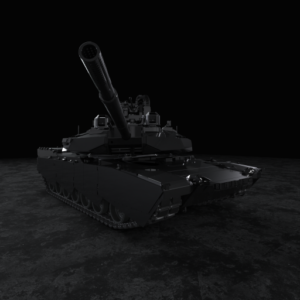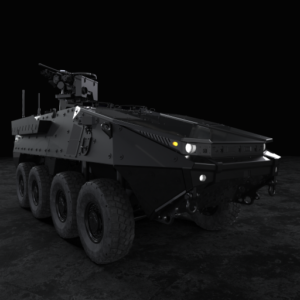General Dynamics Land Systems [GD] next week will unveil two new hybrid-electric technology demonstrator platforms, an AbramsX and StrykerX, as the company aims to showcase its latest in combat vehicle advancements.
Company officials told
Defense Daily the two vehicles, which will both be on display at the Association of the United States Army’s (AUSA) annual conference in Washington, D.C., will highlight new capabilities that could be applied as upgrades to existing fleets or for new combat vehicle programs the Army may pursue.

“These are full-up, actual-size, to scale working vehicles. They’re not only for presentation. They’re not mock-ups. These are actual vehicles that demonstrate this technology,” Tim Reese, GD Land Systems’ director of business development, said in an interview ahead of the AUSA conference. “It’s about what is in the art of the possible today and in the very near-term. We’re not talking about 25 years from now. We’re talking about the very near-term, couple of years, about what is possible on ground combat vehicles, whether that’s on some of the Army’s enduring fleet, like Abrams and Stryker, or for some of the Army’s emerging requirements.”
Keith Barclay, GD Land Systems’ director of U.S. strategy and growth, said AbramsX and StrykerX follow several years of development and a focused investment into the company’s new Katalyst vehicle architecture and advancements to help address areas like reducing logistics burden and getting after silent watch capability.
Barclay added that going after hybrid-electric power with the tech demonstrators was not “driven by environmental concerns,” and noted the AbramsX uses a parallel hybrid-electric power along with Army-developed Advanced Combat Engine (ACE) while StrykerX utilizes series hybrid-electric power.
“We were focused solely on providing capability to soldiers. Imagine, if you will, silent movement from a hide position to an attack position with an Abrams tank. [Think about] your ability to have silent watch for an extended period of time. In the case of the StrykerX, think about your ability to move even longer distances with a series hybrid-electric engine,” Barclay said.
“What you have [with AbramsX] is an ability to reduce the volume and size of the engine, reduce the fuel required but maintain the same or maybe slightly better operating profile of the current tank. So then you have reduced weight, you provided a lot of power and with that you can get rid of the hydraulic system in the tank and go to your electric drive which further reduces weight,” Barclay added on AbramsX.
Reese said the new Katalyst vehicle architecture, which was first announced last year and is also a part of the GD Land Systems’ design for the Army’s Optionally Manned Fighting Vehicle competition, will be featured on both tech demonstrators to further demonstrate technology advancements for future combat platforms.
“That brings advanced computing capability and artificial intelligence to each vehicle based on its mission profiles to make it more capable and/or to reduce the cognitive burden on the crew, which also allows us to reduce the crew size or just make the crew function better,” Reese said, noting Applied Intuition is helping support the Katalyst architecture.

GM Defense [GM] helped out with the internal combustion engine piece of StrykerX’s hybrid-electric power park, the officials told Defense Daily, while AbramsX uses the ACE developed for an Army program by Cummins and a transmission from SAPA.
Reese detailed what attendees will see when AbramsX and StrykerX are shown publicly next week, and how the two demonstrators will differ from the current versions of the platform that are both produced by GD Land Systems.
“The AbramsX is recognizably an Abrams but it’s also very different. You’re going to see this configuration of crew has all three crew personnel in the hole and none in the turret, so the turret is not as tall and it’s more angular and narrow,” Reese said. “The StrykerX also looks different, particularly from the front end. It has a much different front configuration because we were able to move the driver backwards into the vehicle. So that driver and that commander of the crew now sit together more like a crew in an aircraft sharing a common cockpit view of displays.”
Following AUSA, GD Land Systems plan is to remain in dialogue with the Army to gather insights that can help further refine the tech demonstrators and understand how both can inform potential future requirements.
“We’re trying to get feedback from our customers, and not just the Army but primarily, about what capabilities they see…as most important or most promising for their needs. And then we’ll take that information to guide our internal investments after AUSA as well as hopefully start a dialogue with the Army about how to bring those into the stage where they are a requirement and we can build actual prototypes and compete for that business,” Reese said.
Senior Army officials over the summer viewed a demonstration at a BAE Systems facility of the service’s first prototype of a hybrid-electric Bradley fighting vehicle, citing the platform’s silent watch capability as a key attribute (Defense Daily, Aug. 11).
The Army is also pursuing an Electric Light Reconnaissance Vehicle (eLRV) program to inform future requirements, which it has described as the “first and most promising of developmental opportunities being pursued under the tactical and combat vehicle electrification initiative seeking to tackle hybrid or purely electric capabilities for many more combat platforms” (Defense Daily, June 2).